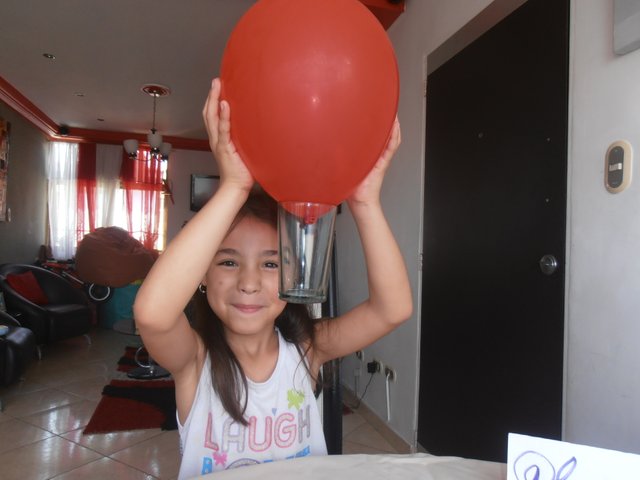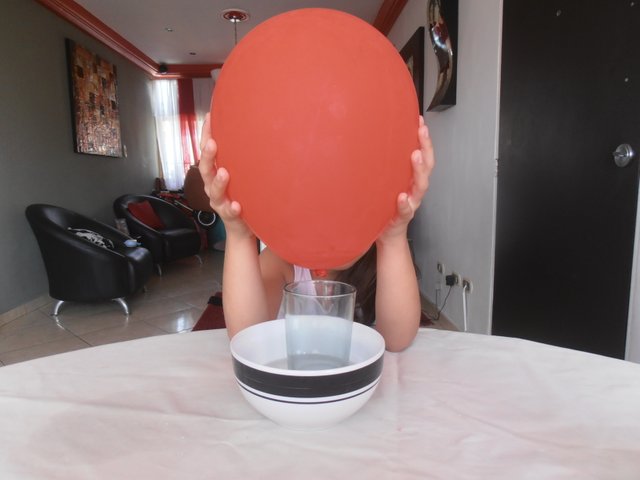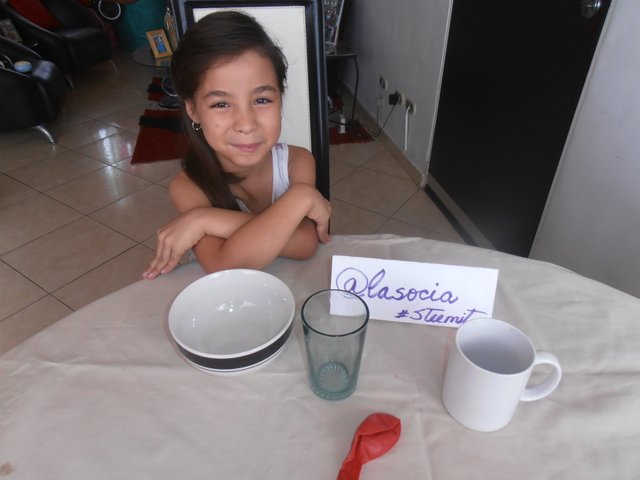Hello friends because of the importance of our children's education and based on the fact that education begins at home, I have decided to publish this post, to show them in an easy and fun way that we can educate our children from home.
Our children are very curious, how little they do not like to experience new things and investigate aspects they do not know and we like their parents and even teachers have the responsibility to find the most appropriate tools to provide them with a quality education !!
The Home Experiments are very useful and we can use a lot! Today I decided to present a very fun experiment that my daughter Sophia loved, she had the most fun and was surprised when I raise a glass with the help of a balloon, today we will learn about the behavior of Gases!
 But before starting the fun we have to study some terms so that the little ones understand what the experiment is about:
What are Gases:
But before starting the fun we have to study some terms so that the little ones understand what the experiment is about:
What are Gases: The word gases corresponds to the plural of the term gas, in as much, by gas it refers to that fluid that tends to expand indefinitely and that is characterized by its small density. In other words, it can be said that gas is the state of aggregation of matter that has no form or proper volume, unlike solids and liquids that do.
- Characteristics of gases:
- The gases have no fixed form or volume, that is, they adapt to the shape and volume of the container that contains them.
- Their atoms and molecules are very separated from each other, there is a lot of space between them. This explains why gases can be compressed so easily.
- The particles that make up the gases have a lot of kinetic energy (movement energy). They are always moving randomly in a straight line and crashing, both between them, and against the walls of the container. With the collisions the particles undergo changes of direction but do not lose kinetic energy (the collisions are elastic).
- The pressure exerted by the gases against the walls of the container that contains them is due to the impacts of the particles against them.
-The kinetic energy increases with temperature. Then, the higher the temperature the more quickly the gas particles move, which translates into more collisions against the walls of the container (higher pressure).
Yes now!! Let the fun begin, let's go with the Experiment !!
How to lift a glass with a balloon!!
The behavior of gases with temperature changes gives a lot of play when having fun doing experiments. Today we are going to make a balloon get stuck in the mouth of a glass. Then we will pull the balloon to raise the glass. We will get it?
Materials:
A transparent glass or cup that supports the heat.
A balloon.
Hot water. It does not need to be boiling.
A bowl.
Process:
Inflate the balloon.
Fill the glass with hot water, count to 10 and then empty the water in the bowl.
The goal is to heat the glass. Place the balloon over the mouth of the glass. It is important that you hold it tight with your hands to prevent the air contained in the glass from escaping into the atmosphere.
After two minutes you can remove your hands. The balloon will be embedded in the glass. In these conditions you can now raise the glass by holding the balloon.

When you want to take out the balloon you just have to put the glass in a bowl of hot water. It will come out right away.

OLYMPUS DIGITAL CAMERA
We go back to the beginning. We heat the glass again.
What has happened?
First of all we have to know that the air that surrounds us and that fills the glass of our experiment is a gas. However:
Hot water With it we have heated the glass and also the air that was inside. The molecules of the gases that make up the air increase their kinetic energy. As the glass is open they can come out freely. Many escape.
We cover the glass with the balloon. From this moment, we have a closed container. The confined air begins to cool, its molecules lose speed (kinetic energy). The collisions against the walls of the glass and against the balloon are less frequent. The pressure inside the vessel is gradually decreasing. However, the external pressure, the atmospheric pressure, remains constant.
The balloon is embedded in the glass. There comes a time when the air pressure inside the vessel is less than the atmospheric pressure. As a consequence, the external pressure pushes the balloon inward and it is trapped. Pulling the balloon upwards, the glass also rises.
Remove the balloon from the glass. To get it without effort, you just have to increase the pressure inside the glass. How? Increasing the kinetic energy of the air molecules, that is, increasing its temperature with a hot water bath in the bowl.
 Children love to do experiments. With them, while having fun, they learnand ask questions about the world around them. Among its many benefits, scientific exploration feeds the child's natural curiosity, fosters his interest in science, stimulates reasoning and logic, improves his ability to solve problems, increases his self-esteem and prepares them to understand more complicated scientific concepts in the future.To enjoy science is not necessary to have a laboratory, you will be surprised by the amount of experiments that can be done with some home materials. So do not wait any longer, get to work and have fun with your children or students.I hope that this article has been of your interest and help, and I hope you in my next publication.Regards!!!
Children love to do experiments. With them, while having fun, they learnand ask questions about the world around them. Among its many benefits, scientific exploration feeds the child's natural curiosity, fosters his interest in science, stimulates reasoning and logic, improves his ability to solve problems, increases his self-esteem and prepares them to understand more complicated scientific concepts in the future.To enjoy science is not necessary to have a laboratory, you will be surprised by the amount of experiments that can be done with some home materials. So do not wait any longer, get to work and have fun with your children or students.I hope that this article has been of your interest and help, and I hope you in my next publication.Regards!!!

Pages reference:
-
https://www.definicionabc.com/general/gases.php
-
https://es.slideshare.net/mnlecaro/caractersticas-de-los-gases-35308117
Posted from my blog with:
https://wordpress.org/plugins/steempress
http://lasocia.vornix.blog/2018/07/26/science-at-home-fun-homemade-experiments-for-the-little-ones-lets-learn-about-gases-and-their-behavior 






You can lift a glass using a balloon!? Very interesting. And certainly fun to learn.
I am going to feature this post in the next Xposed Curator's Rebound #36. You may find details about it Xposed Curator's Rebound
My hope is to bring your quality work here the exposure it deserves, and with it, hopefully some additional rewards.
Congratulations, and best wishes
Congratulations! This post has been upvoted from the communal account, @minnowsupport, by wildlocusthoney from the Minnow Support Project. It's a witness project run by aggroed, ausbitbank, teamsteem, theprophet0, someguy123, neoxian, followbtcnews, and netuoso. The goal is to help Steemit grow by supporting Minnows. Please find us at the Peace, Abundance, and Liberty Network (PALnet) Discord Channel. It's a completely public and open space to all members of the Steemit community who voluntarily choose to be there.
If you would like to delegate to the Minnow Support Project you can do so by clicking on the following links: 50SP, 100SP, 250SP, 500SP, 1000SP, 5000SP.
Be sure to leave at least 50SP undelegated on your account.
great experiments
this is a new lesson for me, I really like it and thank you for the information
regards @arifmunandar070
If you would like to support the educational community by delegating to @steemiteducation, please click on any of the following links. This will ensure that more teachers are supported on a daily basis.
100SP 200SP 300SP 400SP 500SP 750SP 1000SP 2000SP 3000SP 4000SP 5000SP 10,000SP 25,000SP
Great learning post.. me too gonna try😊
This post was shared in the Curation Collective Discord community for curators, and upvoted and resteemed by the @c-squared community account after manual review.
I love to see this kind of experiments ... and certainly with children. They love it, and according to the face of this sweet little girl, she loved it and was very proud of herself to succeed with this experiment. Love to see more experiments ...